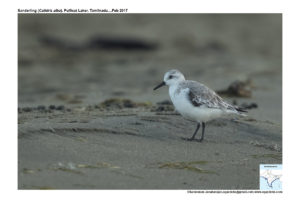Sanderling

Sanderling Calidris alba
Etymology :
- Calidris : Greek word for grey-coloured waterside bird mentioned by Aristotle
- Alba : Latin word for White
Vernacular Names : Mal: Thirakkada, Guj: Dariai lagotho, Dariyayi khichdiyo, Ta: Moondru viral ullan, Manal ullan, Mar: Kavadya Tilawa
Distribution in India: Widespread winter visitor except North, North West and parts of East India.
Description: Size of 20–21 cm; wt. of 40–110 g; wingspan of 35–39 cm. It is chunky, medium-sized with shortish and thickish bill. The intensity of coloration is variable, with head, upperparts and breast mostly pale buff to chestnut. It has dark streaks on head and breast and bold black marks and white spots on upperparts. The underparts are white; in flight, striking white wingbar in all plumages. It lacks a hallux. The female looks similar but averages slightly larger and paler, with less chestnut. The non-breeding adult is very white; pale grey above with white face and white underparts; lesser wing-coverts are darker. The juvenile has buffy white head and breast; streaked crown and sides of breast; upperparts are marked black and grey with almost black shoulder patch. It is found in high Arctic barren stony tundra supporting scant vegetation with well drained ridges and sparse growth of willow and saxifrage; access to shores of neighbouring waters is important requirement for young. In non-breeding season it is found on open sandy beaches exposed to swell of open sea, and sandy outer reaches of estuaries; also rocky or muddy shores, less frequently on mudflats. During migration it is found at inland waters
Food habits: During breeding it eats insects, mainly adult and larval Diptera, beetles and Lepidoptera; spiders and crustaceans and vegetable matter like seeds, saxifrage buds, moss and algae. On migration and in winter it eats small molluscs, crustaceans, polychaete worms, adult, larval andinsects like Diptera, beetles, Lepidoptera, Hemiptera, Hymenoptera, fish, medusae and larger molluscs and crustaceans taken as carrion. It feeds by rapid probing or pecking. Typically, close to water’s edge, following retreating waves. Touch, smell and taste are important for locating prey, and sometimes vision initially. It feeds in small flocks, or very large ones, especially on staging sites. It defends winter feeding territories. It is diurnal and nocturnal forager.
Breeding habits: They breed in Jun to Jul. They are monogamous; occasionally polyandrous. The nest is exposed depression, frequently on bare earth or stones, often lined with dry leaves and lichens. It lays a clutch of 3-4 eggs, with laying interval of 26–29 hours. The incubation period is 24–32 days, done by both sexes. They often lay 2 clutches, each incubated by one parent. The fledging period is 17 days; care for chicks, at least initially when both parents incubate, both probably. The parents depart soon after fledging.